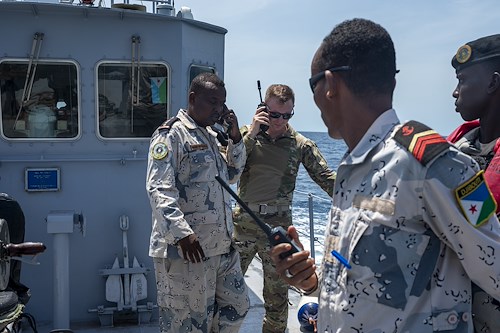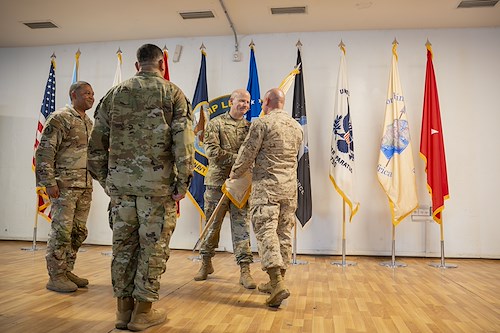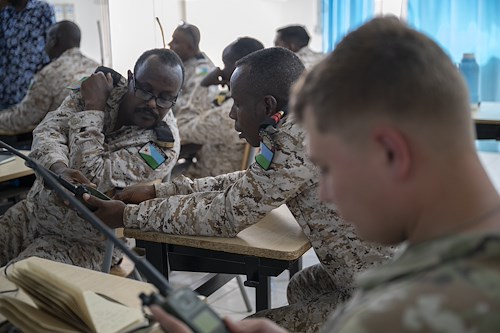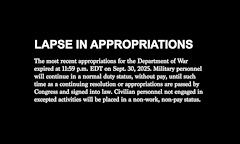Gallery contains 12 images
×
Photo 1 of 12
Combined Joint Task Force - Horn
Service members from Combined joint Task Force - Horn of Africa collaborate with the Djiboutian Coast Guard and partner nations in the 5th iteration of Exercise Bull Shark May 5-6, 2024 in the Gulf of Tadjoura, Djibouti. Bull Shark is a biannual crisis response and personnel recovery exercise designed to test communication and interoperability between like-minded partners.
Photo 2 of 12
Combined Joint Task Force - Horn
Service members from Combined joint Task Force - Horn of Africa collaborate with the Djiboutian Coast Guard and partner nations in the 5th iteration of Exercise Bull Shark May 5-6, 2024 in the Gulf of Tadjoura, Djibouti.Bull Shark is a biannual crisis response and personnel recovery exercise designed to test communication and interoperability between like-minded partners.
Photo 3 of 12
Combined Joint Task Force - Horn
Service members from Combined joint Task Force - Horn of Africa collaborate with the Djiboutian Coast Guard and partner nations in the 5th iteration of Exercise Bull Shark May 5-6, 2024 in the Gulf of Tadjoura, Djibouti.Bull Shark is a biannual crisis response and personnel recovery exercise designed to test communication and interoperability between like-minded partners.
Photo 4 of 12
Combined Joint Task Force - Horn
Service members from Combined joint Task Force - Horn of Africa collaborate with the Djiboutian Coast Guard and partner nations in the 5th iteration of Exercise Bull Shark May 5-6, 2024 in the Gulf of Tadjoura, Djibouti.Bull Shark is a biannual crisis response and personnel recovery exercise designed to test communication and interoperability between like-minded partners.
Photo 5 of 12
Combined Joint Task Force - Horn
Service members from Combined joint Task Force - Horn of Africa collaborate with the Djiboutian Coast Guard and partner nations in the 5th iteration of Exercise Bull Shark May 5-6, 2024 in the Gulf of Tadjoura, Djibouti.Bull Shark is a biannual crisis response and personnel recovery exercise designed to test communication and interoperability between like-minded partners.
Photo 6 of 12
Combined Joint Task Force - Horn
Service members from Combined joint Task Force - Horn of Africa collaborate with the Djiboutian Coast Guard and partner nations in the 5th iteration of Exercise Bull Shark May 5-6, 2024 in the Gulf of Tadjoura, Djibouti.Bull Shark is a biannual crisis response and personnel recovery exercise designed to test communication and interoperability between like-minded partners.
Photo 7 of 12
Combined Joint Task Force - Horn
Service members from Combined joint Task Force - Horn of Africa collaborate with the Djiboutian Coast Guard and partner nations in the 5th iteration of Exercise Bull Shark May 5-6, 2024 in the Gulf of Tadjoura, Djibouti.Bull Shark is a biannual crisis response and personnel recovery exercise designed to test communication and interoperability between like-minded partners.
Photo 8 of 12
Combined Joint Task Force - Horn
Service members from Combined joint Task Force - Horn of Africa collaborate with the Djiboutian Coast Guard and partner nations in the 5th iteration of Exercise Bull Shark May 5-6, 2024 in the Gulf of Tadjoura, Djibouti.Bull Shark is a biannual crisis response and personnel recovery exercise designed to test communication and interoperability between like-minded partners.
Photo 9 of 12
Combined Joint Task Force - Horn
Service members from Combined joint Task Force - Horn of Africa collaborate with the Djiboutian Coast Guard and partner nations in the 5th iteration of Exercise Bull Shark May 5-6, 2024 in the Gulf of Tadjoura, Djibouti. Bull Shark is a biannual crisis response and personnel recovery exercise designed to test communication and interoperability between like-minded partners.
Photo 10 of 12
Combined Joint Task Force - Horn
Service members from Combined joint Task Force - Horn of Africa collaborate with the Djiboutian Coast Guard and partner nations in the 5th iteration of Exercise Bull Shark May 5-6, 2024 in the Gulf of Tadjoura, Djibouti. Bull Shark is a biannual crisis response and personnel recovery exercise designed to test communication and interoperability between like-minded partners.
Photo 11 of 12
Combined Joint Task Force - Horn
Service members from Combined joint Task Force - Horn of Africa collaborate with the Djiboutian Coast Guard and partner nations in the 5th iteration of Exercise Bull Shark May 5-6, 2024 in the Gulf of Tadjoura, Djibouti.Bull Shark is a biannual crisis response and personnel recovery exercise designed to test communication and interoperability between like-minded partners.
Photo 12 of 12
Combined Joint Task Force - Horn
Service members from Combined joint Task Force - Horn of Africa collaborate with the Djiboutian Coast Guard and partner nations in the 5th iteration of Exercise Bull Shark May 5-6, 2024 in the Gulf of Tadjoura, Djibouti.Bull Shark is a biannual crisis response and personnel recovery exercise designed to test communication and interoperability between like-minded partners.
Exercise Bull Shark Enhances Communication Efforts Between the U.S., Ally and Partner Nations
By U.S Army SGT Lark Sine
DJIBOUTI, Djibouti- Service members from Combined joint Task Force - Horn of Africa collaborate with the Djiboutian Coast Guard and Navy, and partner nations in the 5th iteration of Exercise Bull Shark 24-2, May 5-6, 2024 in the Gulf of Tadjoura, Djibouti.
Exercise Bull Shark led by CJTF-HOA is a bi-annual joint training exercise between U.S service members, ally and partner forces to strengthen personnel recovery capabilities and interoperability. The exercise consisted of over 200 U.S., Djiboutian, Spanish, and French service members, 45 vehicles, 15 vessels, and five aircrafts all communicating and working together as a collective whole to ensure readiness to real-world crisis response.
“Communications was a very important part of Bull Shark,” said U.S. Army Sgt. Ethan Judkins, the future operations (FUOPS) plan manager, and member of the 204th Maneuver Enhancement Brigade, from the Utah National Guard, who make up a large segment of the CJTF-HOA team. He helped coordinate radio and satellite communications for the two day exercise. “Without communication, we wouldn't be able to know who was where or what was happening.”
Effective communication is the cornerstone of successful military exercises between partner and ally nations. This was evident during the initial phase of the maritime search and rescue missions performed on the first day. Upon receiving the alert from the U.S. forces, the Djiboutian Navy and Coast Guard promptly responded.
Sergeant Mohamed Ali Moussa, a nurse in the Djiboutian Coast Guard, described how his team coordinated efforts to locate and recover two simulated casualties drowning alone at sea then performed CPR.
“Communication played a role that was very important,” said Mohamed. “If there was no communication, the person could have drowned in real-life.”
What he was learning wasn't novel, but it provided a practical application that reinforced his understanding of the material and enhanced his ability to collaborate with international forces.
“It was my first time working with the United States,” said Mohamed. “It was a good experience.”
As each phase progressed, the importance of reliable communication became increasingly apparent. In the second phase of the exercise, focused on casualty evacuation and personnel recovery, collaboration among forces was paramount. Coordination between the various units was facilitated through various communication channels.
“We primarily used the VHF (Very High Frequency) internally,” said Judkins. ”We used the 163s which are hand held radios, and there were tactical satellites involved to communicate with the birds (aircraft) as well as the Joint Operations Center. We also had Iridium as backups which are satellite phones.”
Amidst the progressing complexities of operations, with each piece of the operation reliant on the next to continue, concerns about potential communication breakdowns often arise.
“We had a plan for each individual element,” said Judkins. “Making sure that if one part of comms went down, we did have a secondary plan, and tertiary as well.”
The Air Force Special Warfare, Pararescue (PJ), assigned to the 82nd Expedtionary Rescue Squadron tasked with the high-stakes mission of jumping out of a KC-130J into the sea to recover personnel, to then be hoisted up to a MV-22 Osprey, rely heavily on that clear and uninterrupted communication. It was critical that the water beneath them be clear for their landing to ensure the safety and success of their missions.
“What do we do if comms go down?” said a PJ assigned to the 82nd EQRS as they were prepping to jump into the Gulf of Tadjoura. “Is there a back-up? Because we don’t want to land on a boat.”
This question underscores the critical need for contingency measures to maintain connectivity and coordination, once again highlighting how paramount the role of communication plays before and during military exercises.
“Any time you go into an operation, you got to have a no comms plan because comms are always going to be something that is a struggle,” said U.S. Marine Corps. Maj. Rich Webb, the “BRONCO” detachment officer in charge of the Marine Medium Tiltrotor Squadron 261’s KC-130J aircraft. “In the modern fight that we have, we could also be getting comms jammed. You might not be able to talk to people that you need to talk to. In this case, a boat circling in the water was our clearance to drop, if we weren't able to get comms for whatever reason.”
As contingency plans were put to the test, communication recovery was being resolved by the tactical radio (TACRAD) team. This team is in charge of operations and maintaining military radios.
“We did actually have a little bit of a hiccup with the International Maritime Radio,” said Judkins. “We ended up changing it at the last second, which the last second change did actually kind of cause issues. We managed to recover that with our internal comms and using the hand held radios. They were able to very quickly switch over and get all of our stuff moving again.”
A team vital to the mission that often stays behind the scenes, the TACRAD team made it possible to coordinate and communicate with our ally and partner nations, and helped drive overall success of the mission.
“Bull Shark was great because we can interact with each other and establish good communication and share all our procedures to complete the same mission,” said a Naval officer in support of Operation Atalanta.. “From the Djiboutian side it was great, because more or less than two months ago we shared military assistance with the coast guard, and now we are working together so it is cool to know that if in any occasion we need them that we have already worked together.”
These sentiments shared reinforce the trust that is built through repeatedly working together. Through repetition, we not only learn best practices, but how to best operate and communicate with each other.
“We need first to continue this,” said Commander-In-Chief Colonel Wais O. Bogoreh the commander-in-chief of the Djiboutian Coast Guard. “As this is the advantage we use to cooperate, coordinate and work together with security issues. With the relationships, we can go a small distance alone, or a long distance together.”
Exercises such as Bull Shark help allies and partner countries in being able to travel farther distances together. Continuously learning how to improve together makes these forces stronger, united, and ready to overcome any obstacle in the way.
“We are in one of the major strategic zones throughout the world where the operational environment changes day to day,” said U.S. Army Capt. Robert Kawczynski, an exercise planner for the CJTF–HOA, CJ-7, who are responsible for training and exercises. “It is important that we are able to communicate with our partners, build the team, fight and execute personnel recovery and crisis response at a moment's notice.”
Joint exercises with national allies and partners such as Bull Shark are essential for seamless communication, sharing crucial information, and enhancing collaborative efforts, ultimately reinforcing preparedness and response capabilities in an increasingly interconnected world.
“It's vital. Without communications, the battlefield becomes disjointed,” said Kawczynski. “Things happen in order or out of order, but not to the control of the participants. Communication is what lets us maneuver the battlefield and ultimately win.”








































